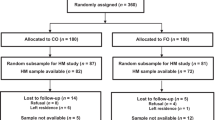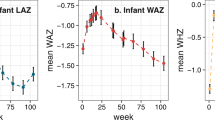Abstract
Objective: To measure the lipid content and the fatty acid (FA) composition of breast milk as part of a nutritional survey of the essential fatty acid (EFA) status of 5 months old Congolese infants.
Design: Cross sectional nutrition survey.
Setting: A suburban district of Brazzaville (capital of the Congo).
Subjects: A random sample of nursing mothers and their 5 months old infants (n=102).
Data collection procedures: The mothers were questionned on their socio-economic status, dietary habits, and their body mass index (BMI) was measured. Breast milk samples were collected from each mother. Milk lipid content and fatty acid composition were determined.
Results: Compared with milk from various countries, Congolese women's mature breast milk was low in lipid (28.70±11.33 g/L) but rich in 8:0–14:0 FAs (25.97±8.17% of total FAs) and in polyunsaturated FAs (PUFAs), particularly n-3 PUFAs (2.39±0.68% of total FAs, mainly 18:3 and 22:6). This was associated with the frequent consumption of high-carbohydrate foods (processed cassava roots, wheat bread, doughnuts) known to enhance 8:0–14:0 FA biosynthesis, and with that of foods providing n-6 and n-3 EFAs such as freshwater and saltwater fish, vegetable oil, green leafy vegetables, and high-fat fruit (peanuts, avocado, bushbutter). These foods were traditionally and locally produced. Milk lipid content was negatively related with mothers' BMI (P<0.01) and varied with the frequency of consumption of certain foods corresponding to distinct dietary patterns.
Conclusions: Lipid content and FA composition of Congolese breast milk were dependent on mother's nutritional status. However, despite an adequate EFA composition of breast milk, partially breast-fed 5 months old Congolese infants probably did not get enough n-6 and n-3 EFAs from breast milk to meet their EFA requirements.
Sponsorship: Supported in part by the French Ministry of Research (contract no. 92.L.0728) and INRA (Institut National de la Recherche Agronomique).
This is a preview of subscription content, access via your institution
Access options
Subscribe to this journal
Receive 12 print issues and online access
$259.00 per year
only $21.58 per issue
Buy this article
- Purchase on Springer Link
- Instant access to full article PDF
Prices may be subject to local taxes which are calculated during checkout
Similar content being viewed by others
Author information
Authors and Affiliations
Rights and permissions
About this article
Cite this article
Rocquelin, G., Tapsoba, S., Dop, M. et al. Lipid content and essential fatty acid (EFA) composition of mature Congolese breast milk are influenced by mothers' nutritional status: Impact on infants' EFA supply. Eur J Clin Nutr 52, 164–171 (1998). https://doi.org/10.1038/sj.ejcn.1600529
Received:
Revised:
Accepted:
Published:
Issue Date:
DOI: https://doi.org/10.1038/sj.ejcn.1600529
Keywords
This article is cited by
-
Correlates of whole-blood polyunsaturated fatty acids among young children with moderate acute malnutrition
Nutrition Journal (2017)
-
Is variation in total antioxidant capacity of human milk associated with levels of bio-active proteins?
Journal of Perinatology (2014)
-
Breast milk fat concentration and fatty acid pattern during the first six months in exclusively breastfeeding Greek women
European Journal of Nutrition (2013)
-
Trans Fatty Acids and Fatty Acid Composition of Mature Breast Milk in Turkish Women and Their Association with Maternal Diet's
Lipids (2009)
-
The influence of Iraqi mothers' socioeconomic status on their milk-lipid content
European Journal of Clinical Nutrition (2006)



